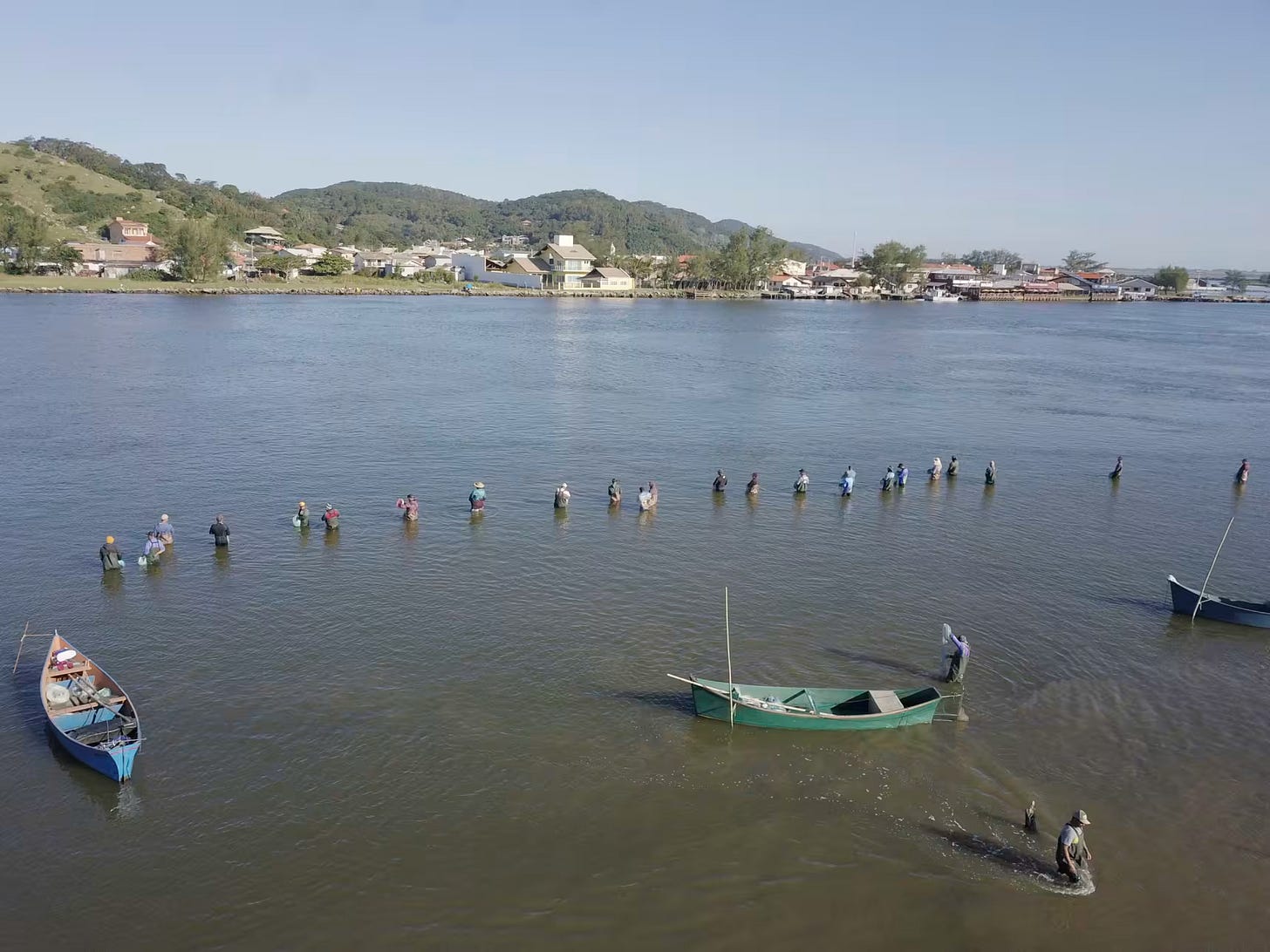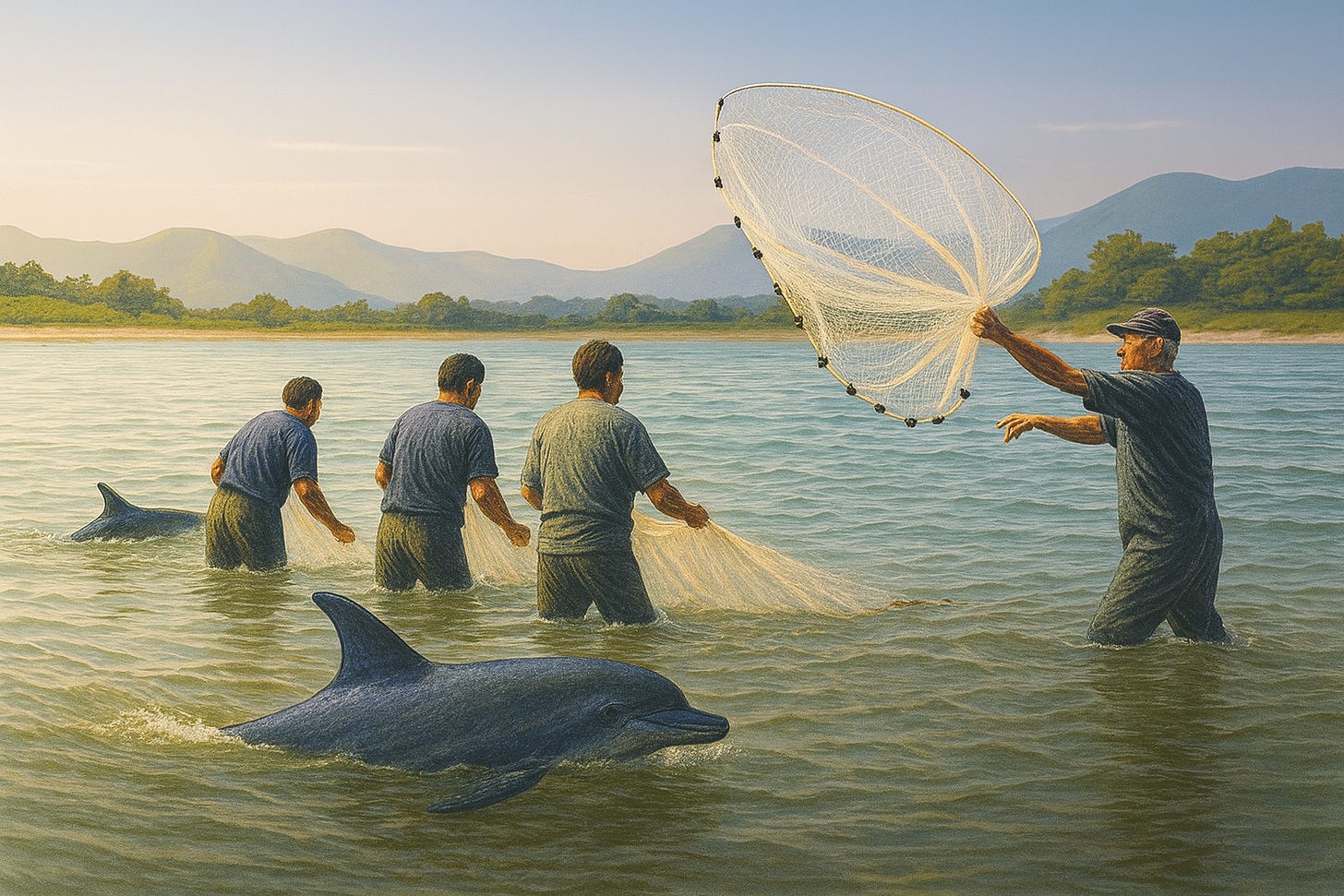When Dolphins Teach Us to Fish
Inside Brazil’s 150-year alliance between humans and dolphins
For over 150 years in southern Brazil, humans and wild dolphins have fished side by side, dolphins driving mullet toward the shore, fishers casting nets on a flick of the fin. A new 2025 study reveals the science behind this extraordinary partnership, synchrony measured in frames of drone footage, hauls over three times larger and dolphins gaining a survival boost. Yet this fragile alliance is now in decline, threatened by overfishing, gillnets, and cultural loss.
The light over the Laguna estuary comes up as fishers stand waist deep in the shallows, nets coiled over their shoulders. Nobody speaks. Everyone stares at the same dark seam of water.
A fin cuts through the surface, then another. Bottlenose dolphins circle the shoal of mullet with small, precise turns. One dolphin rolls, flicks its head toward the beach, and slaps its tail against the surface with a sound like a whip crack. Nets arc through the air. The water erupts silver. Fishers haul heavy mesh to their chests while dolphins slice in to catch their share.
For a few moments, humans and dolphins move like parts of the same machine.

Local families say their grandparents did the same. Newspaper reports confirm the practice has been observed for more than 150 years. But for the first time, science is not only confirming it, it is warning us how fragile it is.
A new study in People and Nature (May 2025) frames Laguna’s fishery as a linked system, where dolphins, people and fish are bound together. Dolphins and fishers are not just sharing fish. They are co-creating a relationship, bound by reciprocity. When the “users” of the system change, when mullet runs falter, when young fishers turn to gillnets, when dolphins stop signalling, the partnership itself begins to fray.
When Data Meets Folklore
Between 2007 and 2018, researchers recorded over 1,600 cooperative fishing events at Laguna. That is not folklore. That is data.
When the team analysed it, the advantages leapt out:
17 times more likely to catch fish when casting on a dolphin cue
Over 3 times larger hauls on average when synchronised with dolphins
Around 13% higher survival for cooperative dolphins compared with non-cooperators
The impact for fishers was staggering: 86% of all 4,955 mullets caught during the study period came from synchronous interactions. In interviews, 98% of experienced fishers confirmed that dolphins gain clear foraging benefits too.
Synchrony is razor sharp. The window between success and failure is often measured in frames of drone footage, not minutes. Cast too early and the net encloses water. Cast too late and the school has scattered. Cast within seconds of the cue, and both predators profit.
Sonar in the Shallows
The water of the estuary is cloudy, stirred by sand and silt. Humans cannot see the fish clearly enough to time their nets. Dolphins solve this with echolocation.
Think of them as carrying portable sonar. Each click sends out a sound pulse; each echo paints a picture. Where humans see murk, dolphins hear maps.
When fishers cast in synchrony, dolphins shift into a “terminal buzz”, a rapid-fire burst of clicks they use only when closing in on prey. It is the sound of precision, of dolphins locking their sonar on the shoal just as the net lands.
Once the school is driven toward the beach, a dolphin gives a cue, a roll, a flick, a tail slap. It is a signal as clear as a whistle. Nets thrown on that beat are many times more successful, and the chaos they cause sends extra fish straight into dolphin mouths.
The payoff is not only in food. Cooperative dolphins spend less time overlapping with hazardous gear. A 13% survival edge might sound small, but for a wild population it is enormous, enough to determine whether a community grows, holds steady, or slides toward extinction.
If you’ve read this far, you know dolphins are not just performers of clever tricks, they are cultural partners, carrying sonar in their skulls and teaching humans when to cast. The next part of this piece dives deeper: how only 20 dolphins sustain 200 families, the names and stories of Scooby and Caroba, and why scientists warn this alliance could vanish within 50 years.
This work is made possible by Ocean Rising’s paid subscribers and Founding Members. You can join them, and unlock the full article today, with a free 7-day trial.
Two Cultures, One Tradition
Not every dolphin joins the hunts. Some specialise, forming their own social cluster. Calves learn by shadowing their mothers through the sequence. People learn the same way, a child stands beside an elder until instinct takes over and the cast happens without thought.
Researchers have found that only about 20 of Laguna’s 55 dolphins cooperate with humans, while the rest use other feeding strategies. These cooperative dolphins form their own network, distinct from non-cooperators. As Dr. Fábio Daura-Jorge notes;
Dolphin societies are very complex, and social interaction seems to drive foraging behavior. The development of specialized foraging may occur in small tight-knit resident communities because there is a high degree of social interaction between the animals.
This is culture, behaviour learned and taught, like a tradition, not hardwired by genes. In Laguna, the culture runs on two tracks - dolphin and human. Each reinforces the other.
Biologists often cite humpback whales passing songs across the Pacific or orcas inheriting dialects. Laguna is different. Here, a non-human culture and a human culture mesh together in a single act.
Fishers know the cooperative dolphins as individuals, not abstractions. They even give them names. Two of the most reliable partners, Scooby and Caroba, have been working alongside humans for more than 15 years. As Daura-Jorge notes;
The fishermen do not fish without the assistance of the dolphins and know the individual animals from their natural marks and can recognize them by eye.

A Fragile Alliance
Despite its elegance, the partnership is at risk. Scientists warn it could vanish within 50 years.
By 2015, mullet catches in southern Brazil were down 80% in some regions, and a government review declared the stock overexploited. That collapse wasn’t caused by the artisanal fishers of Laguna, whose catches remain small and tied to tradition. The real pressure comes from larger coastal gillnet fisheries, whose industrial-scale hauls weaken the very runs on which both dolphins and people depend.
Rising sea surface temperatures make the problem worse, pushing mullet offshore and reducing the chances for synchrony. Studies in Patos Lagoon, further south along Brazil’s coast, show how strongly climate anomalies can hit this species: during El Niño years, when sea temperatures rise and salinity patterns shift, mullet landings have dropped by as much as 30–50%.
Gillnets add another threat. They are invisible walls of nylon. Dolphins that linger near fishers are more exposed. While precise numbers for Laguna’s bottlenose dolphins are lacking, studies of similar artisanal fisheries in southern Brazil suggest that dozens to more than one hundred coastal dolphins die in nets each year.
Noise is rising. Boat engines flood the estuary like static on a radio. The dolphins’ clicks blur into interference. Add runoff, pollution, and plastic debris, and the clarity on which this partnership depends dissolves.
The People and Nature paper points to one more danger: changes in the users of the system. Fewer young fishers stand on the beach. Some turn to other jobs, others adopt gear that does not mesh with dolphin cues. When humans drift away from synchrony, dolphins respond by abandoning the behaviour too.
The scale of what is at stake is striking. Daura-Jorge states that;
We are talking about a small subgroup of dolphins, probably about 20, supporting over 200 families with no other income. If we lose the cooperative dolphins, we lose this unique traditional way of life and vice versa.
Culture may be the most fragile element of all. Calves learn by following mothers. Children learn by standing beside elders. Break the chain on either side, and the memory disappears. Unlike fish stocks, culture does not regenerate.
The Wider Web of Reciprocity
Laguna is not unique. Humans and wild animals have worked together elsewhere.
In Mozambique and Tanzania, honeyguides, small brown birds, lead people to wild hives. Specialised human calls increase the chance of success threefold. The birds feast on wax and larvae; humans take honey.
These alliances remind us that reciprocity between species is not an anomaly. It is a survival strategy, delicate but real, woven into landscapes across the world.
What the Dolphins Teach Us
The People and Nature study framed Laguna as mutual but asymmetric. Humans rely on dolphins for sonar-like information. Dolphins rely on humans for the chaos of nets that drive prey into their mouths. Both sides benefit. Both sides lose if the rhythm breaks.
As Mauricio Cantor, one of the lead researchers, puts it:
“Usually humans gain the benefit, and nature pays the cost, but this interaction has been happening for over 150 years.”
Some scientists have suggested that Brazil could go further and designate the dolphin–fisher relationship as cultural heritage, recognising it as part of the country’s living history. Preserving cultural diversity, Cantor argues, is also a way of preserving biological diversity.
Reciprocity here is not philosophy. It is science. It is measurable in catch rates, survival odds, and drone frames. It is fragile in the face of ecological and social change.
This is why the researchers warn that protecting Laguna means protecting more than dolphins or mullet. It means protecting a relationship, a living feedback loop that links species and generations.
As the tide turns, most fishers step back. One child remains with an elder. A mother dolphin surfaces with her calf and sweeps parallel to the sand. The elder points: “See that turn? She is bringing the fish back.”
The net is cast. The water erupts silver. Dolphins dart through the chaos.
A gesture repeated thousands of times becomes a bridge across species, across generations. The ocean is not always distant. In Laguna it is intimate. Two predators, two cultures, acting in synchrony.
The dolphins are not only teaching us about their world. They are teaching us about ours.
Further reading
Cantor, M. et al. (2023). Foraging synchrony drives resilience in human–dolphin mutualism. PNAS.
Cantor, M. et al. (2025). Changes in the users of the social-ecological system around a reciprocal human–dolphin relationship. People and Nature.
Daura-Jorge, F. et al. (2012). Ecological and anthropogenic drivers of bottlenose dolphin foraging specialization in southern Brazil. PLoS ONE.
Scientific American (2023). A famed dolphin–human fishing team-up is in danger of disappearing.
Smithsonian Magazine (2023). Dolphins and humans work together to catch fish in Brazil.




